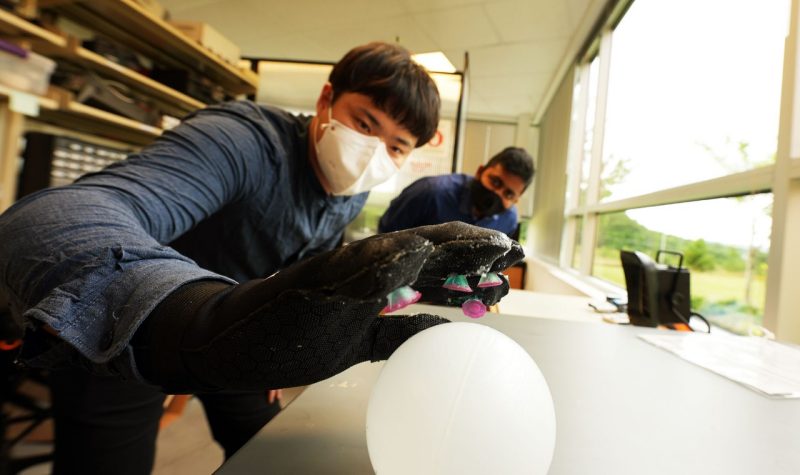
By Alex Parrish
A team of researchers led by Virginia Tech Assistant Professor Michael Bartlett has developed an octopus-inspired glove capable of securely gripping objects underwater. Their research was selected for the July 13 cover of Science Advances.
Humans aren’t naturally equipped to thrive in an underwater environment. We use tanks to breathe, neoprene suits to protect and warm our bodies, and goggles to see clearly. In such an environment, the human hand also is poorly equipped to hold onto things. Anyone who has tried to hold onto a wriggling fish will testify that underwater objects are difficult to grip with our land-dwelling fingers.
“There are critical times when this becomes a liability,” said Bartlett. “Nature already has some great solutions, so our team looked to the natural world for ideas. The octopus became an obvious choice for inspiration.”
Rescue divers, underwater archaeologists, bridge engineers, and salvage crews all use their hands to extract people and objects from water. Human hands with less capability to hold slippery things must resort to using more force, and an iron grip can sometimes compromise those operations. When a delicate touch is required, it would be helpful to have hands made for water.
Those are the very appendages that Bartlett and his fellow researchers sought to build. His team in the Soft Materials and Structures Lab adapted biological solutions into new technologies made from soft materials and robotics.
Grabbing inspiration from powerful adhesion
The octopus is one of the most unique creatures on the planet, equipped with eight long arms that can take hold of myriad things in an aquatic environment. In a beautiful integration of practical tools and intelligence, these arms are covered with suckers controlled by the sea animal’s muscular and nervous systems.
Each sucker, shaped like the end of a plunger, contributes a powerful snatching ability. After the sucker’s wide outer rim makes a seal with an object, muscles contract and relax the cupped area behind the rim to add and release pressure. When many of the suckers are engaged, it creates a strong adhesive bond that is difficult to escape.
“When we look at the octopus, the adhesive certainly stands out, quickly activating and releasing adhesion on demand,” said Bartlett. “What is just as interesting, though, is that the octopus controls over 2,000 suckers across eight arms by processing information from diverse chemical and mechanical sensors. The octopus is really bringing together adhesion tunability, sensing, and control to manipulate underwater objects.”
To design their glove, the researchers focused on re-imagining the suckers: compliant, rubber stalks capped with soft, actuated membranes. The design was created to perform the same function as the sucker of an octopus — activating a reliable attachment to objects with light pressure, ideal for adhering to both flat and curved surfaces.




